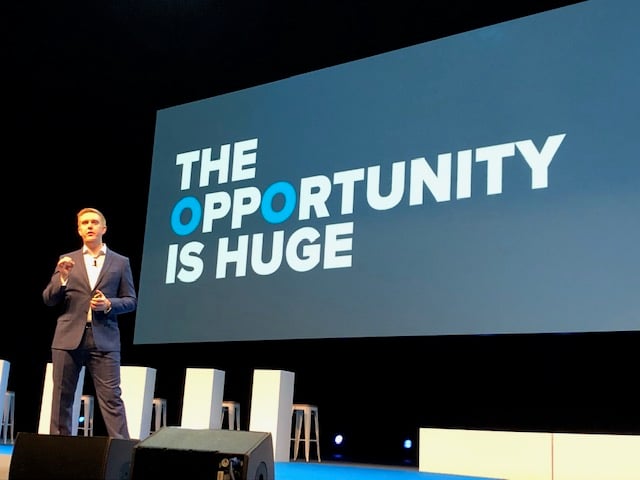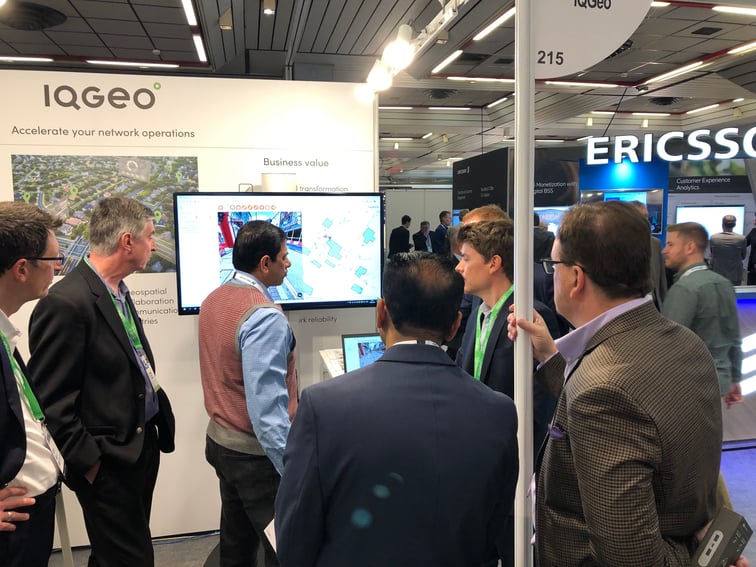I just returned from Digital Transformation World 2019 conference in Nice organized by TM Forum. This is one of the premier annual global events for Communication Service Providers (CSPs), attracting leading providers and technology players from around the world. IQGeo attended to launch our next generation geospatial platform that is changing the face of legacy GIS (read our previous blog post) and to demonstrate our myWorld software together with our recently released products including Workflow Manager and Network Revenue Optimizer.
With a name like Digital Transformation World, it’s not surprising that the theme of digital transformation (DX) featured prominently in the conference agenda. As this was my first year attending, I didn’t know quite what to expect because the topic of DX is not new and often discussed in vague generalities that are difficult to apply in the real world. This said, I was impressed with the pragmatic approach of the conference sessions.
The presentations that I was able to attend, when I could find time away from our stand, provided thoughtful and practical insights. The majority of speakers made a real effort to cut through the hype and hyperbola of DX to share valuable, first-hand perspectives on implementing digital strategies that contribute to creating a truly digital business.

In the sessions I attended, three common digital transformation themes repeatedly emerged.
1 – Digital transformation is a means to an end and not an objective on its own
2 – The customer must be at the center of everything we do
3 – Digital transformation will not be achieved with technology alone
1 - Digital transformation is a means to an end and not an objective on its own
CSPs are engaged in a highly competitive industry and the overriding business objective is to improve and enhance their service. All too often, CSP services are not being compared to other CSPs, but to natively digital OTT providers and even internet B2C players like Amazon.
The competition is fierce, and the stakes are high. Those that succeed will radically change their businesses over the next decade in ways that we cannot even image today. Those that fail to meet the DX challenge will be relegated to commodity providers and will struggle to maintain their place in the communication ecosystem.
DX is the foundation upon which essential business change will be achieved by CSPs, but it’s only the enabler and not the goal. In reality, it makes more sense to talk about business transformation that is linked to a well-defined set of operational objectives.
2 – The customer must be at the center of everything we do
Given the competitive landscape and the digitally savvy competitors, NPS is the single most important KPI for CSPs. The quality of the customer experience will define success or failure.
While this sounds obvious, the complexity of the challenges facing CSPs and the technology at our disposal means that it’s extremely easy to lose sight of this critical principle. Those companies driving the greatest change across their business have put their customers at the very heart of everything they do. They have a razor-sharp focus that links everything all activities back to customer NPS with a clearly defined value-chain.
Projects are not commissioned, and investments are not made, without a value-chain that improves or creates new services and they are ruthless about measuring their success. Even if a project is delivered on time and under budget, it will be killed if it doesn’t deliver the projected results for their customers. Fail fast, learn and move on.
3 – Digital transformation will not be achieved with technology alone
As with all major projects and initiatives, success is achieved by taking a holistic approach that incorporates a variety of factors and DX is no different. People, technology and process have equally important roles to play.
The importance of the right people with the right skills and business culture cannot be overstated. The most inspiring organizations are those that recognize this and make staff training, vision and communication integral to their DX strategy.
Choosing the right technology for the job is also essential, but there is no one-size-fits-all approach. The choice of technology will depend greatly on the specific requirements and priorities of the individual CSPs. Its very important to select technology that can deliver against the defined business and customer service objectives, taking local skills into account. Ideally, selected vendors should also share the cultural values of the CSP, helping to create a long-term partnership that can streamline technology adoption.
The orchestration of people and technology into processes is the third and final element. This is where the pieces come together to create an operational environment that delivers against the business objectives for the customer. Here too, unique requirements of the CSP and their network environment will define these processes and their evolution over time.

Summary
These three DX themes are strategic for CSPs, but they are also an excellent reminder for technology providers like IQGeo. As powerful and compelling as our software is, we need to remind ourselves that it is a piece of the DX puzzle.
We must make sure that we clearly articulate the business benefits we provide in the context of the DX challenge. It is important to explain exactly how our technology is used today to improve NPS though improve service response times, enhancing network uptime and by helping to deploy new and exciting services.
In addition, we cannot forget the human and cultural elements of a successful DX strategy. In the end, people make technology work and as a software provider we have always been focused on a simple, mobile first approach that streamlines processes and user acceptance.
Digital Transformation World 2019 was an excellent event for IQGeo. We met many companies that are taking on the DX challenge and the perspective provided by the conference gives us all a better perspective on what success looks like and how we can work together to create happier customers for global CSPs.

CMO at IQGeo
Similar articles:

 Previous
Previous







